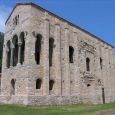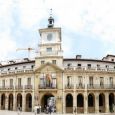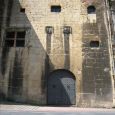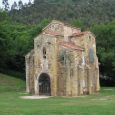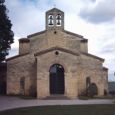Oviedo
Advertisement
By plane
Airport of Asturias (IATA: OVD) is approximately 40km away from Oviedo. The airport is located on the outskirts of the town of Aviles. Asturias airport has flights to and from London Stansted, Amsterdam, Brussels, Lisbon, Milan and Rome, Basil and Zurich, and various destinations in Germany. In Spain there are flights to Madrid, Barcelona, Valencia, Malaga, Alicante, Palma de Mallorca, Sevilla and the Canary Islands.
The bus is by far the cheapest way to get to Oviedo from the airport (5,80 euros). An ALSA coach will leave you in the Bus station, very close to the centre, with connections to local buses, taxis and the train station next to it. Buses are on the right as you exit the terminal and leave every hour from 6.00am to midnight. The journey takes from 40 to 50 minutes.
By train
Oviedo train station is on the west side of la Calle uria , where there are many connecting local bus routes. There is also a taxi stand just outside the station. It is next to the coach station.
By car
There is a convenient ring-road,with various exits into Oviedo. There a places to chance, but they are not near, check directions before getting into A6. Lugones will be your easy option to return. To Oviedo, freeway will take by car in less than 20min to Gijon or Aviles.
By Coach
The Oviedo Coach Station is located in the centre of town, next to the Oviedo train station. There are coach routes to most towns in Asturias and the North of Spain, as well as Madrid and some other Spanish large cities, like Sevilla and Barcelona. International coach routes link Oviedo daily with Paris, Brussels and Genève There is a Tourist Information Office at the bus station
Advertisement
Santa Maria del Naranco
Santa Maria del Naranco is a church Romanesque Asturian located four kilometers from Oviedo , on the southern slope of Mount Naranco which was originally the palace of King Ramiro I . The building now known as Santa María del Naranco not built as a church, it is the most representative building a suburban palace complex built by Ramiro I in s. IX.The building was built by Ramiro I as a palace, being completed in the year 842 AD as part of an architectural complex that also included the nearby church of San Miguel de Lillo , built only one hundred meters away. However, due to the collapse of the head and part of San Miguel ships was transformed into a church, probably during the twelfth century, as the chronic Silos of 1150 and recorded it as the Temple of Santa Maria. The building is located on the southern slope of Mount Naranco where there was a forest abounding in game. The absence of an apse intended to contain the king's throne suggests that the building had to be either a palace or royal residence country devoted to entertainment.
The temple was declared a World Heritage Site by Unesco in December 1985 .
Holy Chamber of Oviedo
The Santa House is a palace chapel which is attached to the Torre de San Miguel, Fruela rest of the Palace and is now integrated into the cathedral -style Gothic of Oviedo . It was built by Alfonso II in the early ninth century when the church rebuilt style Romanesque dedicated to San Salvador and had been erected by Fruela I in the eighth century and later destroyed by the Muslims . During the Revolution of Asturias in 1934 was blown up with dynamite by the insurgent socialists. From the ninth century it saved the treasures and relics of the Cathedral. Many of these relics had been brought from Toledo , as the Holy Ark , the Holy Shroud , relics of the True Cross, the Christ Nicodemus and others to keep them out of Muslim territory and the danger of loss that meant.
San Julian de los Prados
San Julian de los Prados, also known as Santullano, a church is Romanesque in the early ninth century which is located in Oviedo , one of the main samples of Asturian art . The church is dedicated to the martyrs Julian and Vasilisa .
It was declared a Historic Artistic Monument in June 1917 and a World Heritage Site on December 2 of 1998 .
San Miguel de Lillo
The church Romanesque San Miguel de Lillo, dedicated to St. Michael the Archangel , was commissioned to build the 842 by King Ramiro I in Mount Naranco around Oviedo . Located a few meters from Santa Maria del Naranco . Possibly that under chronic Albeldense , this monarch had built with their palaces, palatine church function. In principle could be dedicated to Santa Maria and San Miguel.
Declared a Unesco World Heritage Site in 1985 . In January 2009, warned of an imminent collapse of the structure and an almost irreparable deterioration in general and of the paintings due to the high humidity that plagues. In the year 2011 were carried out works of restoration.
Casa de la Rua
De la Rua's house or house of the Marquis of Santa Cruz de Marcenado of Oviedo is one of the oldest secular buildings in the city. Dating from the fifteenth century it is one of the few buildings that survived the great fire in the city, on Christmas Eve 1521 .
Built in the last quarter of the fifteenth century belonged to counter the Catholic Kings , Rodrigo de la Rua , although the former building belonged to Alonso Gonzalez de la Rua . In the seventeenth century passed to the Marques de Santa Cruz de Marcenado .
This is a clear example of architecture of the Middle Ages , with openings arranged in a disorderly manner on the front and patio garden. The original point of departure of the building was a tower, now included in the building of the XIV century . In 1928 it was rebuilt part of the house by adding an interior garden.
Oviedo city hall
The Oviedo Town Hall was designed in 1622 by the architect Juan de Naveda .After the creation of the municipality by the Charter of Oviedo begins the journey of the town hall.
The rulers as they grow the importance of the town hall decided to move the headquarters of the atrium of the church of San Tirso the new building.
In 1622 Juan de Naveda designed the new building taking advantage of an old wall bracket and door Cimadevilla. In 1671 the works are completed. In 1780 Francisco Pruneda made the first major overhaul.
August - November
Information not available
Advertisement

